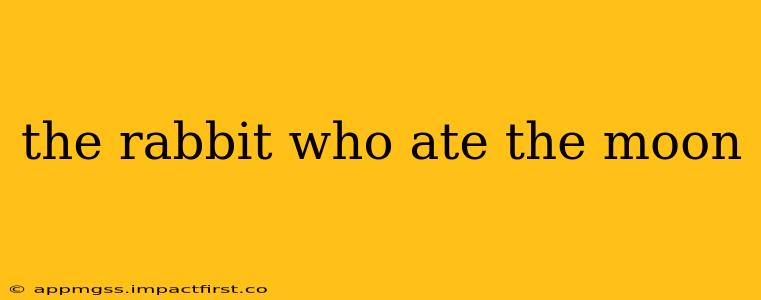The Rabbit Who Ate the Moon: A Deep Dive into Myths, Legends, and Symbolism
The tale of the rabbit who ate the moon, while not a single, universally recognized story, appears in various forms across different cultures. It's a fascinating example of how similar mythological themes emerge independently, reflecting humanity's shared fascination with celestial bodies and the power of storytelling. This exploration delves into the variations of this myth, its symbolic meanings, and the cultural contexts in which it thrives.
What Cultures Have Myths About a Rabbit on the Moon?
Many cultures feature a rabbit or hare on the moon in their mythology. Perhaps the most widely known is the East Asian tradition, prevalent in China, Japan, Korea, and Vietnam. These cultures often depict the moon rabbit pounding mochi (rice cake) or preparing an elixir of immortality. However, the image isn't always associated with eating the moon, but rather inhabiting it, performing a significant task within its celestial realm. Other cultures have similar lunar motifs featuring rabbits, hares, or similar lagomorphs, although the precise actions attributed to them may vary. The shared presence of a rabbit on the moon across diverse cultures highlights the power of shared symbolism and the enduring human fascination with the night sky.
What Does the Rabbit on the Moon Symbolize?
The symbolism associated with the moon rabbit is rich and multifaceted, differing slightly based on cultural context. In many East Asian traditions, the rabbit symbolizes purity, gentleness, and hard work. The act of pounding mochi, a laborious task, emphasizes the rabbit's dedication and perseverance. The association with an elixir of immortality links the rabbit to longevity and the pursuit of transcendence. In other interpretations, the rabbit can represent fertility, lunar cycles, and the connection between the earthly and celestial realms. The ambiguity inherent in these stories allows for multiple levels of interpretation, enriching their symbolic value.
Is There a Story Where a Rabbit Actually Eats the Moon?
While many myths feature a rabbit on the moon, a narrative where a rabbit eats the moon is less prevalent. The image of consuming the moon is a powerful one, suggesting control over celestial forces or a disruption of natural order. While a direct narrative of a moon-eating rabbit might not be widespread, the underlying themes of celestial interaction and the potential for imbalance are found in other lunar myths. These stories often involve eclipses or other celestial events, implicitly highlighting the power and mystery of the moon and its relationship with the earth. Many folk tales feature animals disrupting the natural order through their actions; a moon-eating rabbit could be viewed as an extreme example within this established storytelling tradition.
What are Other Myths and Legends About the Moon?
Numerous myths and legends across cultures feature the moon as a central element. These narratives often explore the moon's influence on human emotions, its connection to the tides, and its significance in various religious and spiritual traditions. Some cultures see the moon as a female deity, others as a male deity, or as an androgynous celestial being. Stories often explore the moon's phases, its connection to the sun, and its role in the cycles of life and death. These diverse interpretations underscore the moon's enduring presence in human mythology and its impact on our understanding of the cosmos.
This exploration provides a deeper understanding of the "rabbit who ate the moon" concept, showing how it's rooted in a wider tapestry of lunar mythology and cultural symbolism. The lack of a single, globally recognized story doesn't diminish the significance of the theme; instead, it showcases the creative capacity of human cultures to interpret and re-interpret the celestial world through their own unique lenses. Further research into specific cultural traditions can reveal even richer details and alternative interpretations of this intriguing motif.
